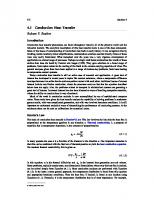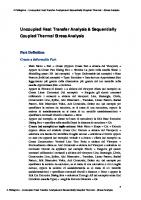Coupled Heat and Mass Transfer in Binary Mixtures at Supercritical Pressures (Springer Theses) 9789811678059, 9789811678066, 9811678057
Supercritical pressure fluids have been exploited in many engineering fields, where binary mixtures are frequently encou
129 100 5MB
English Pages 181 [169]
Table of contents :
Supervisor’s Foreword
Preface
Acknowledgements
Contents
Acronyms
Roman Symbols
Greek Symbols
Superscripts
Subscripts
Abbreviations
1 Introduction to Binary Mixtures at Supercritical Pressures and Coupled Heat and Mass Transfer
1.1 Supercritical Pressure Fluids and Near-Critical Fluids
1.1.1 Critical Phenomena
1.1.2 Anomalies in Physical Properties
1.1.3 Engineering Applications of Supercritical Pressure Fluids
1.2 Coupled Heat and Mass Transfer in Binary Mixtures at Supercritical Pressures
1.3 Literature Review
1.3.1 Introduction to Three Fundamental Problems
1.3.2 Piston Effect
1.3.3 Rayleigh-Bénard Instability
1.3.4 Buoyancy-Driven Flows
1.4 Motivation
1.5 Thesis Outline
References
2 Basic Equations and Physical Properties of a Reference Binary Mixture
2.1 Basic Equations
2.2 Physical Properties
2.3 Phase Diagram and Behavior of Physical Properties of C2H6-CO2
2.4 Summary
References
Part I Coupling Through Cross-Diffusion Effects: Relaxation and Diffusion Problems
3 Coupled Transfer in a Relaxation Process: Mass Piston Effect
3.1 Problem Statement
3.2 Traveling-Wave Theory
3.2.1 Wave Generation
3.2.2 Wave Propagation
3.3 Numerical Validations
3.3.1 Numerical Method
3.3.2 Comparisons and Discussions
3.4 Energy Balance Analysis
3.5 Conclusions
References
4 Coupled Transfer in a Diffusion Problem: Concentration Gradient in the Coexisting Liquid-Like and Gas-Like States
4.1 Problem Statement
4.1.1 Physical Model
4.1.2 Governing Equations for the Motionless Steady State
4.1.3 Summary of Cases
4.2 Numerical Method
4.3 Characteristics for the Coexistence of LL and GL States
4.3.1 State Variables
4.3.2 Physical Properties
4.3.3 Physical Explanation for the Pressure Drop
4.3.4 Heat Transfer Characteristics
4.4 Assessments on the Influences of Concentration Gradient
4.4.1 Influences of Concentration Gradient on the PB
4.4.2 Influences of Concentration Gradient on Pressure Drop and Heat Flux
4.5 Conclusions
References
Part II Coupling Through Cross-Diffusion Effects: Instability and Bifurcation
5 Interactions Between Coupled Transfer and Gravity: Rayleigh-Bénard Instability
5.1 Problem Statement and Approximation
5.1.1 Physical Model
5.1.2 Mathematical Model
5.2 Linear Stability Analysis
5.2.1 Formulation of Stability Problem
5.2.2 Analytical Solution under Ideal Boundary Conditions
5.2.3 Stability Threshold under Various Conditions
5.3 Further Discussions
5.3.1 Origin of the Oscillatory Instability
5.3.2 Relative Importance of Gravity-Related Effects
5.4 Conclusions
References
6 Interactions Between Coupled Transfer and Gravity: Nonlinear Rayleigh-Bénard Convection
6.1 Problem Statement
6.1.1 Physical and Mathematical Models
6.1.2 Response Parameters
6.1.3 Numerical Method
6.2 Preliminary Numerical Simulations
6.3 Weakly Nonlinear Theory
6.3.1 Conditions for Backward Bifurcation at R=Rmonocrit
6.3.2 Relative Magnitude Between Rf.a. and Rosccrit
6.4 Theory-guided Numerical Simulations and Discussions
6.4.1 Results under Partially Satisfied Necessary Conditions
6.4.2 Results under Fully Satisfied Necessary Conditions
6.4.3 Physical Explanation for the Conditions of FA Instability below Rcrit
6.5 Conclusions
References
Part III Coupling Through Boundary Reactions: Buoyancy-Driven Flows
7 Coupled Transfer Through Boundary Reactions: An Application-Oriented Cavity Flow Problem
7.1 Problem Description
7.1.1 Physical Model
7.1.2 Mathematical Description
7.1.3 Initial and Boundary Conditions
7.1.4 Governing Parameters
7.2 Formulations for CO2-Naphthalene System
7.2.1 Solubility
7.2.2 Adsorption and Desorption Reactions
7.2.3 Thermodynamic and Transport Properties
7.3 Theory
7.3.1 Thermodynamic Optimization
7.3.2 Hydrodynamic Optimization
7.4 Numerical Simulations
7.4.1 Numerical Method
7.4.2 Cooperative Regime
7.4.3 The Effects of Cavity Height
7.5 Conclusions
References
8 Summary and Perspectives
8.1 Summary
8.2 Perspectives
Appendix A Numerical Methods for the Linear Stability Analysis of Rayleigh-Bénard Instability under Realistic Boundary Conditions
A.1 Discretization of the Generalized Eigenvalue Problem
A.2 Algorithm for the Optimization Problem
A.3 Numerical Codes for the Linear Stability Analysis
Appendix B The Solubility of Naphthalene in Supercritical CO2
Appendix C The Isobaric Specific Heat of Supercritical CO2-C2H6 System
Supervisor’s Foreword
Preface
Acknowledgements
Contents
Acronyms
Roman Symbols
Greek Symbols
Superscripts
Subscripts
Abbreviations
1 Introduction to Binary Mixtures at Supercritical Pressures and Coupled Heat and Mass Transfer
1.1 Supercritical Pressure Fluids and Near-Critical Fluids
1.1.1 Critical Phenomena
1.1.2 Anomalies in Physical Properties
1.1.3 Engineering Applications of Supercritical Pressure Fluids
1.2 Coupled Heat and Mass Transfer in Binary Mixtures at Supercritical Pressures
1.3 Literature Review
1.3.1 Introduction to Three Fundamental Problems
1.3.2 Piston Effect
1.3.3 Rayleigh-Bénard Instability
1.3.4 Buoyancy-Driven Flows
1.4 Motivation
1.5 Thesis Outline
References
2 Basic Equations and Physical Properties of a Reference Binary Mixture
2.1 Basic Equations
2.2 Physical Properties
2.3 Phase Diagram and Behavior of Physical Properties of C2H6-CO2
2.4 Summary
References
Part I Coupling Through Cross-Diffusion Effects: Relaxation and Diffusion Problems
3 Coupled Transfer in a Relaxation Process: Mass Piston Effect
3.1 Problem Statement
3.2 Traveling-Wave Theory
3.2.1 Wave Generation
3.2.2 Wave Propagation
3.3 Numerical Validations
3.3.1 Numerical Method
3.3.2 Comparisons and Discussions
3.4 Energy Balance Analysis
3.5 Conclusions
References
4 Coupled Transfer in a Diffusion Problem: Concentration Gradient in the Coexisting Liquid-Like and Gas-Like States
4.1 Problem Statement
4.1.1 Physical Model
4.1.2 Governing Equations for the Motionless Steady State
4.1.3 Summary of Cases
4.2 Numerical Method
4.3 Characteristics for the Coexistence of LL and GL States
4.3.1 State Variables
4.3.2 Physical Properties
4.3.3 Physical Explanation for the Pressure Drop
4.3.4 Heat Transfer Characteristics
4.4 Assessments on the Influences of Concentration Gradient
4.4.1 Influences of Concentration Gradient on the PB
4.4.2 Influences of Concentration Gradient on Pressure Drop and Heat Flux
4.5 Conclusions
References
Part II Coupling Through Cross-Diffusion Effects: Instability and Bifurcation
5 Interactions Between Coupled Transfer and Gravity: Rayleigh-Bénard Instability
5.1 Problem Statement and Approximation
5.1.1 Physical Model
5.1.2 Mathematical Model
5.2 Linear Stability Analysis
5.2.1 Formulation of Stability Problem
5.2.2 Analytical Solution under Ideal Boundary Conditions
5.2.3 Stability Threshold under Various Conditions
5.3 Further Discussions
5.3.1 Origin of the Oscillatory Instability
5.3.2 Relative Importance of Gravity-Related Effects
5.4 Conclusions
References
6 Interactions Between Coupled Transfer and Gravity: Nonlinear Rayleigh-Bénard Convection
6.1 Problem Statement
6.1.1 Physical and Mathematical Models
6.1.2 Response Parameters
6.1.3 Numerical Method
6.2 Preliminary Numerical Simulations
6.3 Weakly Nonlinear Theory
6.3.1 Conditions for Backward Bifurcation at R=Rmonocrit
6.3.2 Relative Magnitude Between Rf.a. and Rosccrit
6.4 Theory-guided Numerical Simulations and Discussions
6.4.1 Results under Partially Satisfied Necessary Conditions
6.4.2 Results under Fully Satisfied Necessary Conditions
6.4.3 Physical Explanation for the Conditions of FA Instability below Rcrit
6.5 Conclusions
References
Part III Coupling Through Boundary Reactions: Buoyancy-Driven Flows
7 Coupled Transfer Through Boundary Reactions: An Application-Oriented Cavity Flow Problem
7.1 Problem Description
7.1.1 Physical Model
7.1.2 Mathematical Description
7.1.3 Initial and Boundary Conditions
7.1.4 Governing Parameters
7.2 Formulations for CO2-Naphthalene System
7.2.1 Solubility
7.2.2 Adsorption and Desorption Reactions
7.2.3 Thermodynamic and Transport Properties
7.3 Theory
7.3.1 Thermodynamic Optimization
7.3.2 Hydrodynamic Optimization
7.4 Numerical Simulations
7.4.1 Numerical Method
7.4.2 Cooperative Regime
7.4.3 The Effects of Cavity Height
7.5 Conclusions
References
8 Summary and Perspectives
8.1 Summary
8.2 Perspectives
Appendix A Numerical Methods for the Linear Stability Analysis of Rayleigh-Bénard Instability under Realistic Boundary Conditions
A.1 Discretization of the Generalized Eigenvalue Problem
A.2 Algorithm for the Optimization Problem
A.3 Numerical Codes for the Linear Stability Analysis
Appendix B The Solubility of Naphthalene in Supercritical CO2
Appendix C The Isobaric Specific Heat of Supercritical CO2-C2H6 System

- Author / Uploaded
- Zhan-Chao Hu


![Heat and Mass Transfer [4]
0256114439, 9780256114430](https://ebin.pub/img/200x200/heat-and-mass-transfer-4-0256114439-9780256114430.jpg)

![Fundamental of Heat and Mass Transfer [7 ed.]](https://ebin.pub/img/200x200/fundamental-of-heat-and-mass-transfer-7nbsped.jpg)
![Heat and Mass Transfer [2, 2020 Ed.]
9789811539879, 9789811539886](https://ebin.pub/img/200x200/heat-and-mass-transfer-2-2020-ed-9789811539879-9789811539886.jpg)
![Heat and Mass Transfer [7 ed.]
9789352533848](https://ebin.pub/img/200x200/heat-and-mass-transfer-7nbsped-9789352533848.jpg)
![Heat and Mass Transfer [5 ed.]
8285444382](https://ebin.pub/img/200x200/heat-and-mass-transfer-5nbsped-8285444382.jpg)

